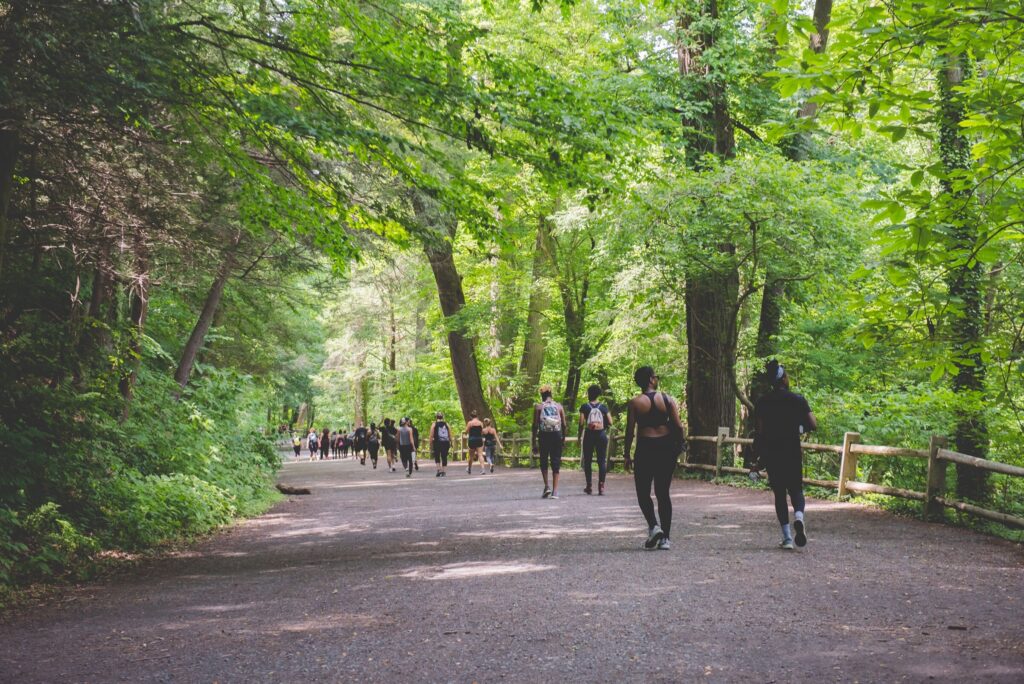The young american robin squeaked like a rewinding cassette tape as Margaret Rohde took the bird out of a cloth bag.
Rohde, conservation manager with Wissahickon Trails, had untangled the robin a few minutes earlier from one of six mist nets she and Kristy Morley, senior naturalist, had set up before dawn at the Crossways Preserve, in Blue Bell, Montgomery County.

The morning in early August followed a tight rhythm: check the nets, process the birds, release them, repeat. The first round had yielded a wood thrush, a house wren and a couple cat birds.
Rohde had found this particular robin in the second round. After she removed the bird from the bag, she proceeded to hold its wing against a ruler, examine its feathers to confirm its age and rattle off a series of measurements. Morley jotted down the notes in a ledger. Rohde and Morley had set up their field station—a couple folding tables under a pop-up tent—in a mowed right-of-way that cuts through the forest at the preserve.
Rohde took a few steps out of the tent before lowering her face mask and blowing onto the robin’s belly, parting its feathers so she could assess how much fat the bird had stored up under its skin. Then Rohde attached a small aluminum band to the robin’s leg, reciting its unique code to be entered in the ledger.
Wissahickon Trails has caught and banded birds at Crossways Preserve since 2015 and contributes the data to the Monitoring Avian Productivity and Survivorship (MAPS) program, which seeks to guide bird conservation efforts in the United States and Canada by collecting and analyzing information on their population trends.
That population information is also useful locally.
“We care about what’s happening with birds here,” says Rohde. “This is really helpful for us in terms of figuring out how our land-management strategies are working or not. We’ve been doing a lot of active management on the preserve. We’ve removed several acres of invasives and we’ve planted about 400 trees and shrubs, so we’re trying to increase the native diversity.”
Morley pointed out other related research projects at the preserve, including one assessing the caterpillar population.
“We have volunteers going out and whacking branches with sticks and catching the caterpillars or any other kind of insects that fall off,” she says.
More native plants should feed more native insects, which should feed more native birds, according to Rohde.
“We’re trying to have, like, a lot more pollinator species in the meadow,” she explains. “We’re kind of starting at the lower trophic level, fixing the habitat.”
MAPS began in 1989, but ornithologists have been banding birds for research since the turn of the 20th century. Birds can fly but humans cannot, which poses a fundamental research hurdle: How do you keep track of a bird after it flies out of view?
The bands, stamped with identifying information, allow anyone who gets the bird in hand again to know where it had been caught the first time, when it had been banded and by whom. With capture after capture, bird banding has revealed bird migration patterns and answered other questions, such as how long they live and how they use habitat for breeding, for wintering and even for molting their feathers.
Rohde, who says she has been obsessed with birds since age 6, discovered bird banding in college.
“I took an ornithology class,” she recalls. “We visited a banding station and I lost my mind, seeing people handle birds.” Various field research positions involving bird banding followed until she began working for Wissahickon Trails in 2015, kicking off the research at Crossways.
Rohde released the young robin, which clucked as it made a beeline for the trees. Most banded birds don’t end up being caught again at the original site for a variety of reasons. Fledglings might roam before they settle down, birds returning after spring migration might end up nesting in different spots and some die before they can be recaptured, all of which makes repeat captures especially exciting, according to Rohde.
“That’s the coolest part,” she says. “We recently had a song sparrow from 2015, and at that time we aged it as a second-year bird, so we know it’s 6 years old.”











